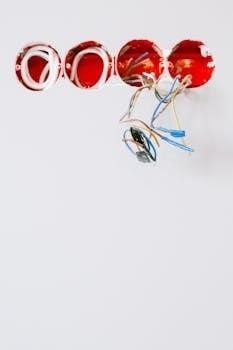Industrial electrical schematics are essential for understanding complex electrical systems. They serve as a roadmap for design, installation, and troubleshooting. These diagrams use standardized symbols to represent components, making them universally readable by professionals. Learning to interpret these schematics is a crucial skill for anyone working in the electrical field.
Importance of Reading Schematics
The ability to read electrical schematics is paramount for anyone involved in industrial electrical work. These diagrams are not just abstract drawings; they are the language of electrical systems. Understanding schematics enables efficient troubleshooting, allowing technicians to quickly identify and resolve issues within complex machinery. They also provide a clear blueprint for proper installation and maintenance, ensuring systems are set up correctly and operate safely. Furthermore, schematics are crucial for designing new systems and modifying existing ones, acting as the foundation for all electrical engineering projects. Without this skill, working with industrial electrical systems would be incredibly difficult and potentially dangerous, highlighting the importance of schematic literacy.
Understanding Basic Electrical Symbols
Electrical schematics rely on a set of standardized symbols. These symbols represent various components, from resistors and capacitors to switches and power supplies. Recognizing these symbols is essential for schematic interpretation.
Common Component Symbols
Understanding common component symbols is fundamental to reading electrical schematics. Resistors, often depicted as zig-zag lines, restrict current flow, while capacitors, shown as parallel lines, store electrical charge. Inductors, represented by coiled lines, create magnetic fields. Diodes, with their triangle and line symbols, allow current to flow in one direction. Batteries, with their long and short parallel lines, provide electrical energy. Ground symbols, depicted as horizontal lines, indicate a reference point; These symbols form the basic building blocks of electrical diagrams, enabling engineers and technicians to understand circuit layouts and functions effectively.
Symbols for Switches and Relays
Switches and relays are critical components in electrical circuits, and their symbols are vital for schematic interpretation. A simple switch is shown as a line with a break and an angled connection. A normally open (NO) contact is depicted as two lines that are not touching, indicating an open circuit when not activated. A normally closed (NC) contact shows two lines connected, implying a closed circuit until actuated. Relays, which use an electromagnet to control a switch, are represented by a coil symbol and associated contact symbols. Understanding these symbols is essential for deciphering control systems and automation circuits.

Standards and Conventions
Adherence to standards is crucial for consistent interpretation of schematics. IEC and JIC are common standards, ensuring symbols and practices are internationally recognized. These standards facilitate clear communication among engineers.
IEC Standards for Symbols
The International Electrotechnical Commission (IEC) establishes comprehensive standards for electrical symbols used in schematics. Specifically, IEC 60617 is a widely adopted standard, also known as BS 3939, that provides a detailed set of graphical symbols for various electrical components. These symbols are designed to be unambiguous and universally understood, promoting clarity in circuit diagrams. IEC standards also cover ladder-logic symbols, as defined in IEC 61131-3, essential for programmable logic controllers (PLCs). Adhering to IEC standards ensures that schematics are consistent and easily interpreted across different regions and industries, facilitating effective communication among engineers and technicians worldwide, ensuring the correct implementation of designs. The use of these standards is vital for clarity and consistency.
JIC Standards and Industrial Usage
Joint Industrial Council (JIC) standards, though less prevalent now than IEC, are still encountered in older industrial schematics, particularly in North America. JIC standards, historically significant, provided a set of symbols for industrial equipment and control systems. While many industries have shifted towards IEC standards for global consistency, understanding JIC symbols remains essential when dealing with legacy systems. JIC symbols are approved and adopted for use in industrial settings and often include specific symbols for hydraulic and pneumatic systems, alongside electrical components. Recognizing JIC symbols enables professionals to work with older machinery and ensures compatibility when integrating newer and older equipment. Familiarity with both IEC and JIC standards is beneficial for complete understanding.

Types of Electrical Diagrams
Electrical diagrams come in various forms, including one-line and three-line schematics. These different styles serve specific purposes in representing electrical systems. Each offers a unique way to visualize and understand circuit behavior.
One-line and Three-line Schematics
One-line schematics simplify complex power systems, representing all three phases with a single line and focusing on the main components and their connections. These diagrams are useful for understanding the overall power flow and for high-level system analysis. They often include protective devices and major equipment, providing a broad overview. In contrast, three-line schematics depict each phase individually, showcasing every wire and connection point. This detailed approach is essential for precise wiring and troubleshooting, allowing for a deeper understanding of the system’s intricacies and the specific role of each component in the circuit. These diagrams are crucial for detailed design and installation tasks.

Practical Application
Electrical schematics are vital for troubleshooting, allowing technicians to trace circuits and identify faults. They also guide design, ensuring accurate system implementation. This makes them indispensable tools in industry.
Troubleshooting Using Schematics
When troubleshooting industrial electrical systems, schematics are invaluable. They act as a detailed map, allowing technicians to trace the flow of electricity and pinpoint the exact location of a fault. By understanding the symbols and connections, one can quickly identify open circuits, short circuits, or component failures. The schematic provides a logical framework for diagnostics, eliminating guesswork and saving time. It allows for systematic checks, starting from the power source and moving through the circuit until the issue is located. This method ensures efficient and effective troubleshooting, minimizing downtime and ensuring safety during repairs.
Designing with Electrical Schematics
Electrical schematics are fundamental to the design process of industrial electrical systems. They provide a clear and concise representation of how components will interact within the circuit. Engineers use these diagrams to plan the layout, select appropriate components, and ensure the system meets safety standards. Schematics allow for early identification of design flaws and prevent costly mistakes during the physical build. They also facilitate communication between design teams, installation crews, and maintenance personnel, as everyone works with a common visual reference. The process allows for efficient modifications, expansions, and future upgrades to the electrical system, ensuring scalability and longevity.

Learning Resources
Numerous online courses and training programs are available to learn about electrical schematics. Symbol libraries and software can also aid in creating and understanding these diagrams, enhancing practical skills.
Online Courses and Training
Several online platforms offer comprehensive courses on reading electrical schematics, catering to different skill levels. These courses often include video lectures, interactive quizzes, and practical exercises to reinforce learning. Many focus on industrial applications, covering standard symbols and conventions used in the industry. Some courses provide certifications upon completion, adding value to your professional profile. Look for courses that emphasize hands-on practice and real-world examples. Additionally, live online courses provide direct interaction with instructors, allowing for personalized guidance. These resources can significantly improve your schematic reading skills. They often cover both basic and advanced concepts.
Symbol Libraries and Software
Access to comprehensive symbol libraries and specialized software is crucial for effectively creating and interpreting electrical schematics. Many software options offer extensive libraries of industry-standard symbols, ensuring consistency and accuracy in diagrams. These tools often include features for creating custom symbols and managing complex projects. Some programs have built-in error checking, which helps prevent mistakes. Vector-based software is particularly useful for producing high-quality schematics. These libraries and software also frequently adhere to international standards. Utilizing these resources enhances the efficiency of schematic creation and analysis. They often streamline the design process and improve collaboration among teams.